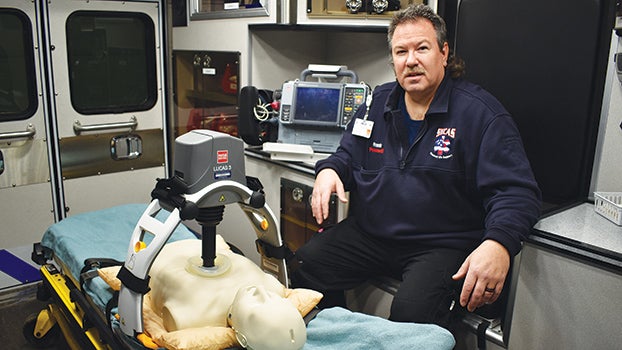SMCAS purchases automated CPR technology
Published 9:55 am Thursday, January 17, 2019

- DeLaTorre demonstrates how LUCAS 3.0 works on a dummy. The equipment is suctioned to the chest and delivers continuous CPR. (Leader photo/KELSEY HAMMON)
NILES — When emergency responders rush to the scene to help a cardiac arrest victim, they need to complete multiple tasks in addition to CPR to give that person the best chance of survival.
That means administering medicine, checking monitors and their airway, while also delivering consistent chest compressions for sometimes as long as an hour. This year, SMCAS responders will face the task with a cutting-edge piece of equipment at the ready.
The nonprofit ambulance service acquired three LUCAS 3.0 machines. The robots are capable of administering chest compressions. The equipment is suctioned to the person’s chest and smart technology helps the device to gauge how much pressure is needed based on the size of the person.
The equipment was obtained by SMCAS late last year. After training their personnel, they put the machines to use at the start of the new year. A LUCAS 3.0 is available in each of SMCAS’s three on-duty ambulances. The equipment has already been used in the field to help a patient.
Brian Scribner, the executive director of SMCAS, called the machines a “Christmas miracle.” Each LUCAS 3.0 machine costs about $16,000. Last year, LUCAS technology officials got in touch with SMCAS, offering them last year’s model at nearly half the cost. Scribner said this was within SMCAS’s budget and they were able to purchase the three machines at the discounted rate. Additionally, he said all LUCAS 3.0 models undergo regular servicing. When the machines are serviced, they will be upgraded to match the current model.
The new technology gives paramedics a better chance of delivering the best life-saving tactics they can.
“In order to do high-quality CPR in settings like homes and outside of the hospital it is a big challenge because you need a lot of people that are trained right to do continuous CPR during the cardiac arrest,” Scribner said.
Completing CPR takes a lot of strength, too. In some instances, chest compressions are needed for 45 minutes to an hour. While American Heart Association guidelines specify that every two minutes, responders should switch to deliver compressions, a person may get tired and be inconsistent during the job, but the LUCAS 3.0 does not.
“This can just constantly go,” said Frank DeLaTorre, a SMCAS paramedic captain.
Additionally, the technology frees up paramedics to concentrate on other life-saving aspects of the job.
“Because of our limited access and the limited amount of people we have out in the field, this definitely helps,” DeLaTorre said.
The LUCAS 3.0 battery lasts for up to 45 minutes and is equipped with a backup battery.
“We can just switch batteries and we have 90 minutes of continuous non-stop CPR,” DeLaTorre said. “A person [administering CPR] will get tired after a while, may not go as deep every time or be in the same placement. With this [technology] you can do everything. You can start your IVs, and the only time you need to pause it is during a pulse check.”
If the person is resuscitated, the machine can be halted with the press of a button.
While DeLaTorre said the machines would help paramedics to deliver the best life-saving tactics that they can, he said one of the essential tools to prevent death during cardiac arrest is teaching people to do CPR.
“We are arriving with an unknown amount of downtime beforehand,” DeLaTorre said. “What it’s really going to take to get more saved [lives] is getting people publically trained to recognize the signs of cardiac events.”
SMCAS is municipally owned and serves residents across southwest Michigan. Scribner said he is glad to have LUCAS 3.0 as part of their team.
“To know that one will always be responding in every ambulance [at the scene] makes us pretty happy,” Scribner said.






